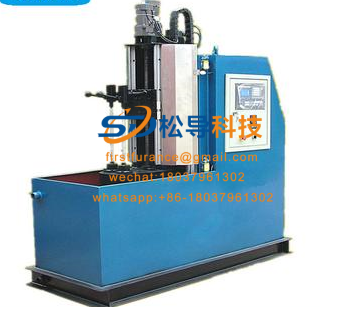
1 , quenching process analysis
( 1 ) Relationship between heating power and heating time (moving speed) and heating temperature
Through multiple induction heating quenching process tests, it is concluded that after a certain temperature is reached, the heating speed is slowed down due to the loss of heat of the workpiece and the energy and heating energy transmitted to the core are close to equilibrium. According to the results of this test, the mid-frequency induction heating quenching process of the rear axle of the commercial vehicle has a reasonable heating power selection of 50-60Kw .
( 2 ) Relationship between heating time (moving speed) and quenching hardness
Table 1 parameters table
diameter φ( mm ) | Hardened layer depth Xk (mm) | Moving time t(s) | Unit power Po(Kw) | Heating power P(Kw) | Movement speed V (mm/s) |
65.5 | 2.8-5.0 | 1.0 | 1.2 | 58 | 6-12 |
47 | 2.8-7.0 | 2.1 | 0.85 | 50 | 6-12 |
35 | 2.8-5.0 | 5.6 | 0.85 | 33 | 6-12 |
34.5 | 2.8-5.0 | 2.4 | 0.85 | 32 | 6-12 |
33.7 | 2.8-5.0 | 67.5 | 0.85 | 30 | 6-12 |
29 | 2.8-5.0 | 9.1 | 0.80 | 30 | 6-12 |
31.7 | 2.8-5.0 | 3.3 | 0.90 | 55 | 6-12 |
Table 2 rear housing induction hardening auxiliary workschedule
Pressing time t1(s) | start up T2(s) | close the door T3(s) | sensor Falling in place T4(s) | Warm up T5(s) | Delay Spray T6(s) | Lens sensor T7(s) | Open the door T8(s) | Top lift T9(s) | Auxiliary working time t(s) |
4 | 2 | 2 | 5 | 5 | 6 | 2 | 2 | 4 | 32 |
When the heating power is 50-60 Kw , the quenching hardness is indirectly controlled by controlling the moving speed because the continuous heating quenching process is employed. The induction heating quenching process test shows that when the moving speed is 15 mm/s , the hardness is 50 HRc , and the metallographic structure is martensite and ferrite. When the moving speed is slowed down to 6 mm/s , the corresponding heating time is prolonged, the hardness is 54 HRc , and the metallographic structure is martensite. This is due to the fact that the austenite is more uniform as the moving speed is slowed down and the heating time is extended, the hardenability of the steel and the carbon content in the martensite are increased. Therefore, the mid-frequency induction heating quenching process of the rear axle of the commercial vehicle, the moving speed (heating time) is 6-12mm/s .
2 , the relationship between heating time (moving speed) and the depth of hardened hardened layer
As the moving speed is slowed down and the heating time is prolonged, the surface heat of the part is transmitted to the core, which makes the austenite more uniform and the hardness increases after quenching. When the moving speed is slowed down to less than 6 mm/s , it is meaningless, because when the moving speed is slowed down to 6 mm/s , the depth of the hardened layer is already close to the upper limit, and the half shaft is made of 40Cr steel, and the hardened layer depth is There is still potential, and it is necessary to develop the rear axle drive shaft of the car with deep depth of the hardened layer in the future to adapt to the development trend of the deeper hardened layer of the rear axle of the automobile. Therefore, the mid-frequency induction heating quenching process of the rear axle of the commercial vehicle, the moving speed (heating time) is 6-12mm/s .
Through the above relationship between heating power and heating time (moving speed), depth of hardened layer and surface hardness, the optimal process for medium frequency induction heating quenching of the rear axle of commercial vehicle is: heating power 50-60Kw , moving speed 6-12mm/s , continuous spraying with 5% concentration of KERUN KR6480 water-soluble quenching agent.

